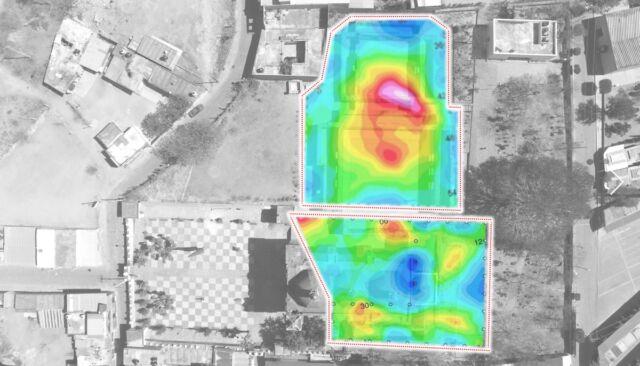The entrance to the underworld was right where legends said it would be.
TIM NEWCOMB
Source - https://www.popularmechanics.com/science/archaeology/a44475021/archaeologists-found-ruins-of-famous-backdoor-to-hell/
Project Lyobaa created a 3D model of a system of caves and passageways known as the “backdoor to Hell” in southern Mexico.
The ancient Zapotecs believed the subterranean site to be an entrance to the underworld.
The location under a church matches local lore of where the entrance was all along.
 Seismic tomography scan of the Church Group at the frequency of 4.76 Hz, revealing areas of low velocity (in blue) that could indicate the presence of underground chambers or natural cavities.
Seismic tomography scan of the Church Group at the frequency of 4.76 Hz, revealing areas of low velocity (in blue) that could indicate the presence of underground chambers or natural cavities.
All you needed to do to find the “backdoor to Hell” was to search underneath what is known as the ancient Church Group site. Long thought to be nothing more than local legend, the lore proved correct. The Project Lyobaa research team discovered a system of caves and passageways believed to be the “hellish” entrance, also known as the temple of Lyobaa, in the southern Mexican state of Oaxaca at the famed Mitla ruins.
Project Lyobaa–a collaboration between the nonprofit Archeology Research and Exploration (ARX) Project, the Mexican National Institute of History and Anthropology (INAH), and the National Autonomous University of Mexico—made use of a mixture of ancient legend and modern-day technology.
In 1674, Francisco de Burgoa—a 17th century Dominican chronicler—gave an account of exploring subterranean temples containing four interconnected chambers with a group of Spanish missionaries. They found tombs of priests and kings of Teozepotlan. And then came the most intriguing—a stone door that led to a cavern as deep as 90 miles (yeah, we’re not sure how that’s possible either) into the Earth, complete with intersecting passages and a pillar-supported roof.
Fearing that this was a literal backdoor to Hell, the missionaries reportedly had the underground labyrinth sealed off.
Finding this site hundreds of years later took the combined powers of ground-penetrating radar, electrical resistivity tomography, and seismic noise tomography. For the first time in Mexico, according to the group, the three methods combined for an “accurate 3D model of what lies beneath the ground.”
The teams says that “the findings confirm the existence of extensive underground chambers and tunnels underneath the Church Group of the ancient site, in the same location claimed by colonial documents and the local tradition to be the entrance to the great subterranean temple of Lyobaa.”
The team believes that the findings—which also included evidence of an earlier construction stage of the Palace of the Columns—will help rewrite the history of the Mitla ruins in Mexico, a site known for five distinct groupings of buildings. The Columns Group and Church Group have been extensively excavated, restored, and now open to the public.
Searching under the main altar of the Catholic church, the team found a large void that appeared to connect with an additional geophysical anomaly to the north of the church. The data then revealed two east-west passages 16 to 26 feet below ground, and opened a view into the underground construction.
“The arrangement of chambers and tunnels underneath the church displays a far greater and more complex articulation than the relatively simple cruciform chambers that exist under the Columns Group and in other parts of the site,” the team writes. “Both the depth and orientation of the newly identified chambers suggest that they may not have been originally connected to the buildings above ground.”
The search isn’t over. The ARX Project plans to return in September to research additional groups of buildings at Mitla, hoping to find further subterranean chambers. At least for the time being, there’s no plan to dive deep and physically explore this “backdoor to Hell.”